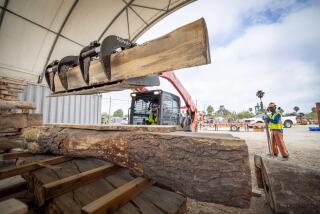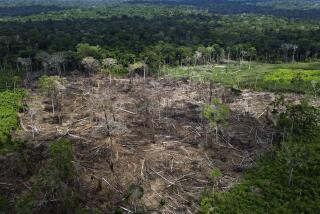Chilean Timber Firms Eyeing Argentina
- Share via
SANTIAGO, Chile — Strapped for land at home, Chilean timber companies are looking to the lush soil and virgin forests of northern Argentina to maintain their rapid growth.
Twenty-five years after a forestry boom began in Chile, land is getting hard to find. The country has 2 million hectares (5 million acres) of plantations, slightly more than all of Brazil.
“Without a doubt, it is easier to expand in Argentina,” said Fernando Raga, head of forestry development at Cia. Manufacturera de Papeles y Cartones SA, or CMPC.
Still, the $2.5-billion-a-year forestry industry will remain a motor behind Chile’s economic growth for at least 15 more years as existing plantations mature and companies shift gears to produce more value-added products. For example, companies are producing increasing amounts of clearwood pine (knotless), which fetches far higher prices. Moreover, local companies continue to extend plantations, with 99,857 hectares planted last year.
While pine production alone is expected to rise to 36.9 million cubic meters in 2017, from the current 17.7 million cubic meters as plantations mature, the number of new plantations is down from a high of 130,429 in 1992.
“It is getting harder to find suitable land in Chile,” Raga said. “We are buying land at 40 hectares a time, compared with 1,000 hectares in Argentina.” That makes a big difference when you need over 50,000 hectares for a pulp mill.
*
Most of the land available in Chile is good pasture land, which is more expensive and requires a high return on investment to make it profitable. That makes it suitable for high-yielding eucalyptus plantations, but not the pine Chile’s forestry industry has been based on to date.
Chile could double the 300,000 hectares of eucalyptus it currently has, Raga said. However, the returns from eucalyptus have proved disappointing, especially for smaller farmers. “It’s more complicated than pine,” Raga said. “It dies with frost.”
That has helped encourage expansion in Argentina. Still, many obstacles remain, including a dearth of knowledge of the forestry industry in Argentina and high labor costs.
CMPC has planted 35,000 hectares of pine plantation in Argentina over the last few years, compared with the 258,000 hectares it has in Chile.
Chile’s Maderas y Sinteticos SA, or Masisa, has planted 10,000 hectares in Argentina and plans to increase that to 65,000 in the next 10 years. Masisa, which produces particleboard and medium-density fiberboard for the furniture and construction industries, recently started production in Argentina.
*
Chile’s largest forestry company, Cia. de Petroleos de Chile SA, or Copec, which has almost 500,000 hectares of land in Chile, also expanded into Argentina.
Last month, Copec’s forestry unit, Celulosa Arauco y Constitucion, agreed to pay $287 million for 95% of the Argentine wood pulp producer Alto Parana SA. Parana owns about 30,000 hectares of land in Misiones, the region of Argentina that stretches between Brazil and Paraguay.
“We are not just buying a pulp plant, we are buying potential growth,” with Argentina offering access to the giant Mercosur market, embracing Brazil, Paraguay and Uruguay, said Alejandro Perez, Arauco’s general manager.
“Argentina has some incredible fast-growth rates” for trees, said Andres Katz, a forestry engineer at New Zealand’s Carter Holt Harvey in Chile. “The average in Misiones is higher than almost anywhere else in the world.”
The semi-tropical climate is perfect for pine trees, with rich, red soil washed down from Brazil.
Yet, Misiones won’t be the center of Argentina’s forestry industry. Small land holdings and vast tracks of native forest will hamper development.
“You could only buy 50 or 100 hectares at a time,” Katz said. There is no market for land there with small, poor farmers unwilling to give up their only source of income.
Forestry companies are unlikely to slash down the centuries-old native forests either.
Corrientes to the south offers better opportunities, with land more readily available. Still, the terrain is flat with the water table only 1.5 meters below the surface, making part of the land unsuitable for forestry, Katz said.
For the moment, “forestry is small-scale and inefficient in Corrientes, but the area has great potential,” Katz said.
More to Read
Sign up for Essential California
The most important California stories and recommendations in your inbox every morning.
You may occasionally receive promotional content from the Los Angeles Times.










